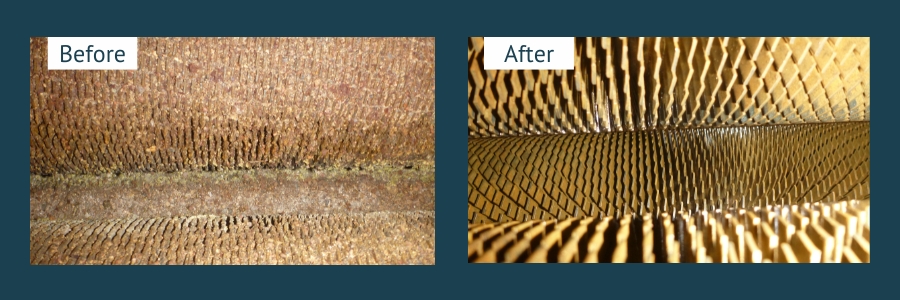5 Reasons Why Convection Section Fouling Removal is the Key to Maintaining Plant Efficiency

Fired heater convection tubes can be difficult to clean effectively, but it is crucial to maintaining plant efficiency and production rate. Fired heaters have the greatest running cost of fixed equipment in refineries and petrochemical sites, and need to be cleaned regularly to prevent fouling or blockages from causing unplanned outages and reduced performance.
1. Improve Heat Transfer Efficiency
Maintaining a high thermal efficiency rate in fired heaters is essential for plants to operate at optimum levels. Many fired heaters have a thermal efficiency of around 85-90%; a decrease of 1-2% in efficiency can lead to the consumption of an additional $1m in fuel over a 12-month period.
Find out how Tube Tech helped increase thermal efficiency by 3% at Turpas Izmir Refinery
Degradation in the convection sections of fired heaters, including issues of scale, oxidation, and fouling, result in higher fuel consumption rates and increased stack temperatures. These higher temperatures cause excess stress on the fired heater tubes, creating uneven expansion and irregular distribution. This can lead to tube failures and emergency outages which has a significant financial impact. Therefore, it is critical that regular maintenance is carried out to mitigate risks associated with poor heat transfer efficiency.
Tube Tech offers a complimentary technical evaluation service to benchmark your fired heater performance against design operational standards. Click here to book your free technical evaluation.
2. Reduce CO2 Emissions
Managing Environmental, Social and Governance (ESG) has become an increasingly important factor for refineries across the globe. This is partly because oil refineries are some of the largest contributors to the total emissions generated by industrial activities.
A global inventory of carbon dioxide (CO2) emissions recently published by One Earth suggests that global cumulative emissions could be reduced by up to 10% between 2020-2030 if refineries adopted low-carbon measures. The list of measures includes refineries improving their efficiency and upgrading heavy oil processing technologies.
Fuel combustion accounts for almost 80% of refinery carbon emissions. In fact, fired heaters are the largest consumers of fuel in a refinery emitting an estimated 400 to 500 million tons of carbon dioxide (CO2) every year, so even minor improvements in the efficiency of fired heaters can lead to significant savings.
3. Improve Asset Life
Given the high running cost of fired heaters, it is essential that they perform at maximum efficiency to avoid losing profit. Regularly cleaning your fired heater convection section is essential to improving their life span, which often ranges from five to fifteen years depending on its construction material.
With attempts being made to increase turnaround cycles (3-5 years continuous operating period being common), effective cleaning and maintenance is vital to ensure equipment can run for longer periods of time to maximise profitability.
Tube Tech’s convection section cleaning technology removes 90%+ fouling from convection tubes, restoring thermal efficiency and identifying any areas of concern. In contrast, traditional hydro blasting techniques only remove 20-30% of fouling, requiring assets to be taken offline more frequently and thus impacting long-term profits.
4. Identify Blocked or Warped Tubes
When exposed to extreme temperatures for extended periods of time, convection tubes may start to sag or bow. Although hardly visible, even a small warp in one of these tubes can prevent the circulation of flue gas. This often leads to overheating and a reduction in efficiency, both of which demand higher amounts of fuel to operate at the optimum rate.
Failing to organise regular cleaning of the convection section in fired heaters increases the likelihood of blockages developing. These blockages, however severe, decrease the heater’s efficiency by building up between the square and triangular pitch rows of convection tubes.
Tube Tech’s convection section cleaning robot detects blocked or warped tubes and adjusts its cleaning path to prevent further damage. The on-board HD camera captures images and videos for reporting and maintenance purposes, making it easier and faster to identify and fix defects.
Identify blockages and warped tubes at an early stage with a Tube Tech Fired Heater Inspection. Contact us to book yours.
5. Reduce Fuel Consumption
Just 1mm of fouling, whether from decoke effluent or fuel system impurities, can hinder the performance of a convection bank by increasing its stack temperature. This temperature increase leads to greater energy consumption, which is financially costly, as well as damaging to a plant’s environmental credibility.
Fouling is a common issue in fired heaters, as airborne particulates from the surrounding area become trapped in the convection section fins and reduce heat transfer efficiency. Extremely hard deposits can form deep within each tube row and are difficult to remove using traditional fired heater cleaning techniques. If left for long periods of time, the affected fired heaters begin to lose efficiency and must use more fuel to reach the required output.
Regularly maintaining your fired heaters will ensure that they perform to design capabilities. A comprehensive Planned Preventative Maintenance (PPM) programme should be in place to achieve optimum fired heater performance.
Summary
Fired heaters are a critical piece of equipment for refineries. With rising fuel costs and stringent emissions legislation, it is becoming increasingly important to ensure that mission critical assets, particularly fired heaters, are performing efficiently and at full capacity.
Maintaining these assets regularly and thoroughly will maintain output, increase asset life, reduce the likelihood of unplanned outages, reduce stack temperatures and emissions, and deliver a significant ROI.
Book a free fired heater technical evaluation
